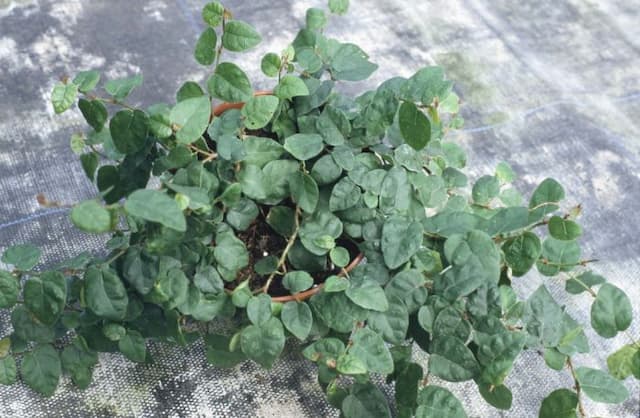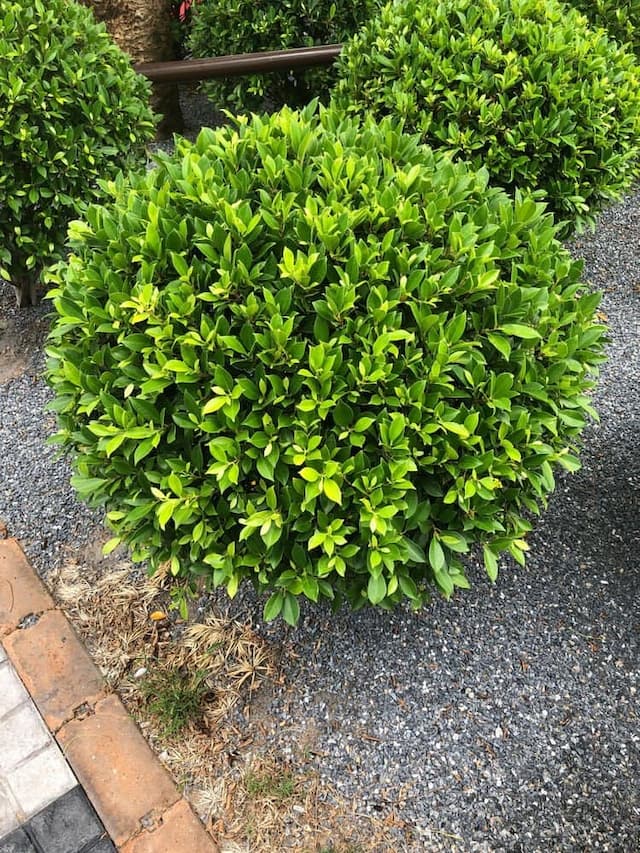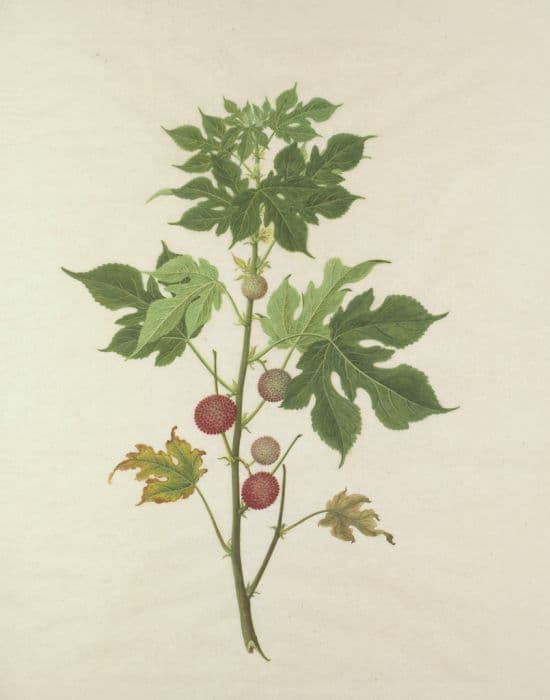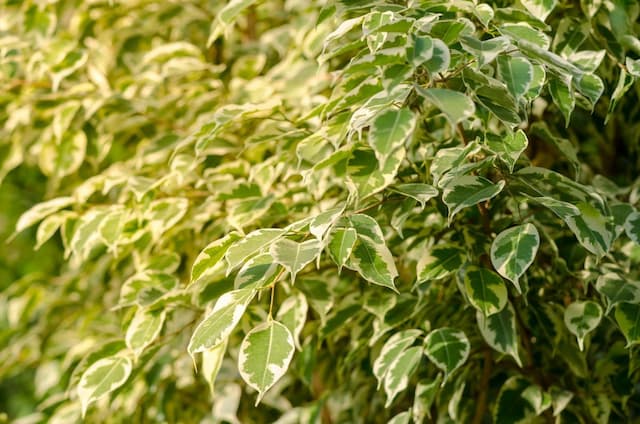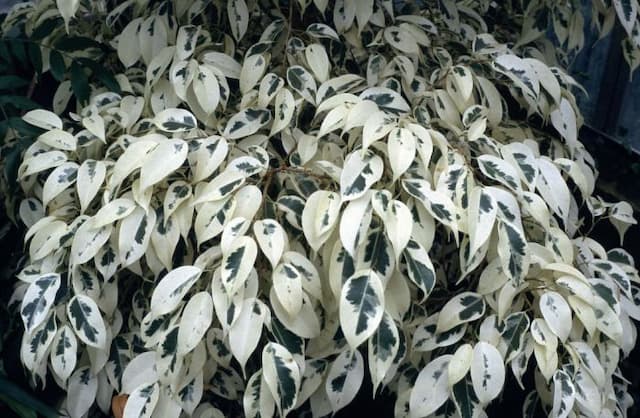Common fig Ficus carica (F)

ABOUT
The common name for Ficus carica (F) is the fig tree. This plant is known for its distinctive large, deeply lobed leaves that have a rough upper surface and a softer underside. The leaves are typically a rich green color and often have three to five lobes, with some variation among different trees. The fig tree's bark is typically a smooth, light grey in color when young, becoming more rugged with age. As for the fruit, fig trees produce unique fruits that are initially small and green, growing into a pear-like shape as they mature. Upon ripening, the figs often turn a deep purple or a greenish-brown color, depending on the specific variety. The interior of the fruit is filled with a sweet, reddish flesh that contains numerous tiny, edible seeds that contribute to the fruit’s distinctive texture. The fruits are well known for their sweet flavor and are often enjoyed fresh or dried. The fig tree is also characterized by its branching habit, producing a wide, spreading canopy that is often laden with fruit during the growing season. The branches can grow in a twisting manner, adding to the visual interest of the plant. Overall, the fig tree has a lush, tropical appearance with rich, full foliage, and it serves both an ornamental and a fruit-bearing role in many gardens and landscapes.
About this plant
 Names
NamesFamily
Moraceae.
Synonyms
Common Fig, Fig, Edible Fig, Smyrna Fig, Higo.
Common names
Ficus carica var. genuina (Kuntze), Ficus carica var. domestica (Kunth & C. D. Bouché), Ficus carica var. caprificus (Risso), Ficus carica var. sylvestris (Risso), Ficus carica var. rupestris (Hausskn. ex Boiss.), Ficus carica var. hibernica (Loudon), Ficus carica var. colchica (Grossh.), Ficus carica var. afghanistanica (Warb.), Ficus carica var. bacillaris (Warb.), Ficus carica var. bivonana (Miégev.), Ficus carica var. bornmuelleri (Warb.), Ficus carica var. cotica (Warb.), Ficus carica var. palmata (Vahl), Ficus carica var. radicans (Warb.), Caprificus insectifera (Gasp.), Caprificus oblongata (Gasp.), Caprificus pedunculata (Gasp.), Caprificus rugosa (Gasp.), Caprificus sphaerocarpa (Gasp.), Ficus colchica (Grossh.), Ficus cupressoides (Gasp.), Ficus dottata (Gasp.), Ficus globosa (Gasp.), Ficus hypoleuca (Gasp.), Ficus hyrcana (Grossh.), Ficus kopetdagensis (Pachom.), Ficus kotschyana (Fenzl ex Fisch. & C. A. Mey.), Ficus latifolia (Salisb.), Ficus leucocarpa (Gasp.), Ficus polymorpha (Gasp.), Ficus praestans (Gasp.), Ficus pycnocarpa (Gasp.), Ficus pycnophylla (Gasp.).
 Toxicity
ToxicityTo humans
The plant known as the common fig is generally not toxic to humans when consumed. The edible fruit of this plant is widely enjoyed and poses no toxic threat when ripe. However, the sap of the common fig contains furocoumarins and can cause phytophotodermatitis, a condition where skin becomes inflamed after contact with the sap and subsequent exposure to sunlight. Symptoms may include irritation, rash, or inflammation on areas of the skin that have come into contact with the sap.
To pets
The common fig is considered to be of low toxicity to pets. However, ingestion of the plant, especially the leaves, can cause gastrointestinal discomfort in some animals. Symptoms of ingestion could include vomiting, diarrhea, and abdominal pain. While it is not typically lethal, pets showing any adverse effects after consuming any part of the common fig should be taken to a veterinarian for appropriate care.
 Characteristics
CharacteristicsLife cycle
Perennials
Foliage type
Deciduous
Color of leaves
Green
Height
10 23 (3 7 meters)
Spread
10 23 (3 7 meters)
Plant type
Tree
Hardiness zones
8
Native area
Mediterranean
Benefits
 General Benefits
General Benefits- Nutritional Value: Figs (the fruit of Ficus carica) are rich in vitamins, minerals, and dietary fiber, essential for a healthy diet.
- Sweetener Alternative: Figs can be used as a natural sweetener due to their high sugar content, which makes them a healthy substitute for processed sugars.
- Culinary Versatility: The fig is used in a variety of culinary dishes, both sweet and savory, offering a unique flavor and texture.
- Garden Aesthetics: Ficus carica is an attractive plant, with broad leaves and a distinctive shape that can enhance garden aesthetics.
- Shade Provision: The canopy of Ficus carica can offer a pleasant shade in gardens and outdoor spaces during sunny days.
- Wildlife Support: Figs provide a source of food for wildlife, including birds and pollinators, which can help support local ecosystems.
- Soil Enrichment: When fig leaves fall and decompose, they help to enrich the soil with organic matter, benefiting garden health and productivity.
- Erosion Control: The root system of Ficus carica can help stabilize the soil and prevent erosion in some environments.
- Cultural and Historical Significance: Figs have been cultivated for thousands of years and hold cultural significance in many traditions, adding a historical dimension to gardens and landscapes.
 Medical Properties
Medical Properties- Antioxidant effects: Ficus carica (F) or common fig fruit and leaves contain compounds that have shown antioxidant properties, which can help to neutralize free radicals in the body.
- Anti-inflammatory properties: Extracts from the fig fruit and leaves have been noted for their anti-inflammatory effects, which might be beneficial in reducing inflammation-related conditions.
- Laxative effects: Figs have traditionally been used to aid digestion and act as a natural laxative due to their high dietary fiber content.
- Antidiabetic potential: Some studies suggest that fig leaves may have a role in lowering blood sugar levels and improving insulin sensitivity.
- Antimicrobial activity: The sap and extracts from fig plants have displayed antimicrobial properties against certain bacteria and fungi.
- Wound healing: Fig extracts have been traditionally used to promote wound healing due to their potential to speed up the regeneration of skin cells.
- Lipid-lowering effects: There is some evidence that fig leaf extracts may help in reducing plasma lipid levels, which could be beneficial for cardiovascular health.
 Air-purifying Qualities
Air-purifying QualitiesThis plant is not specifically known for air purifying qualities.
 Other Uses
Other Uses- The leaves of the fig tree can be used as a natural dye, providing a range of yellow, tan or light green hues for fabrics.
- Fiber from the bark of the fig tree is occasionally used for crafting small traditional items like baskets and mats in some cultures.
- The latex sap of the fig tree, which is milky and sticky, has been used as a natural chewing gum or a binder for traditional crafts.
- In some regions, fig tree wood, being relatively pliable, is utilized to create musical instruments like drums.
- The fruit of the fig tree can be used to make a natural and biodegradable face or body scrub when dried and ground.
- Fig leaves can be applied as a natural fish or meat wrapper for grilling, imparting a subtle, smokey flavor to the food.
- When dried, fig tree leaves can serve as a natural flavoring agent for smoking foods, offering an aromatic quality to meats and cheeses.
- Figs can be fermented to create an alcoholic beverage, similar to the way grapes are used to make wine.
- Fresh figs are often used in the culinary world as a natural sweetener in desserts and baked goods, reducing the need for added sugars.
- The fig tree's large leaves provide an eco-friendly alternative to plastic wraps and foils for covering dishes or food items as temporary storage.
Interesting Facts
 Feng Shui
Feng ShuiThe Fig Tree is not used in Feng Shui practice.
 Zodiac Sign Compitability
Zodiac Sign CompitabilityThe Fig Tree is not used in astrology practice.
 Plant Symbolism
Plant Symbolism- Prosperity and Abundance: Ficus carica, commonly known as the Common Fig, has been a symbol of abundance due to its many seeds and prolific fruit production, representing fertility and plenty.
- Knowledge and Wisdom: In some cultures, the fig tree is associated with knowledge and wisdom, perhaps in part because of its connection with the biblical story of Adam and Eve, where fig leaves were used as clothing after they gained knowledge of good and evil.
- Peace and Wellbeing: Because fig trees can live for hundreds of years, they often symbolize peace and longevity. Their presence in gardens and landscapes is seen as a serene influence.
- Self-Sufficiency and Independence: A fig tree is known for its ability to grow and produce fruit with minimal care, symbolizing self-sufficiency and the ability to provide for oneself.
 Water
WaterThe common fig, or Ficus carica, should be watered deeply once a week, providing about 1-2 gallons of water per session during the growing season. During the winter months, reduce watering to every two to three weeks depending on the climate. Ensure that the soil is well-drained and does not become waterlogged. If the fig is planted in a container, water it when the soil's surface feels dry to the touch, but don't let the soil dry out completely.
 Light
LightFicus carica, commonly known as the common fig, thrives in full sunlight conditions. The ideal spot for planting a common fig is in a location where it can receive at least 6-8 hours of direct sunlight daily. The plant will perform best with plenty of light, so a south-facing location is optimal when considering placement in the Northern Hemisphere.
 Temperature
TemperatureThe common fig, Ficus carica, prefers warm and consistent temperatures, typically between 70°F and 85°F. It can survive minimum temperatures of 15°F, but the roots should be protected from freezing. The ideal growing conditions include protection from strong winds and avoiding locations where temperatures drop below 15°F, as frost can severely damage the plant.
 Pruning
PruningThe common fig, known as Ficus carica, requires pruning to maintain health, encourage fruit production, and manage its size. Prune the common fig in the dormant season, usually late winter, by removing dead or diseased wood and thinning out crowded branches. You may also cut back the tree to shape it and encourage new growth, which typically bears the fruit. Pruning should be done annually for optimal health.
 Cleaning
CleaningAs needed
 Soil
SoilThe common fig (Ficus carica) thrives in well-draining soil rich in organic matter, with a pH between 6.0 and 7.0. A good soil mix might consist of 1 part garden soil, 1 part peat moss or compost, and 1 part perlite or vermiculite to ensure proper drainage and aeration. Regular monitoring and adjustment of pH can help maintain the ideal conditions for the fig tree's growth.
 Repotting
RepottingThe common fig (Ficus carica) should be repotted every 2-3 years to ensure it has enough space for root growth and adequate nutrients. Younger or more vigorous trees may require more frequent repotting. When repotting, upgrade to a pot that is 1-2 inches larger in diameter to accommodate the growing roots.
 Humidity & Misting
Humidity & MistingThe common fig (Ficus carica) prefers moderate humidity levels but is adaptable to various conditions. Ideally, the humidity level should range from 30% to 50% for optimal growth, but common figs can tolerate lower humidity environments.
 Suitable locations
Suitable locationsIndoor
Place common fig in bright indirect light, ensure pot has drainage.
Outdoor
Plant in full sun, shelter from wind, water regularly.
Hardiness zone
8-11 USDA
 Life cycle
Life cycleThe common fig (Ficus carica) starts its life cycle from a seed, which upon germination produces a small root system and a shoot that grows into a sapling. As the plant matures, it develops a woody stem and creates a robust root system, with large, lobed leaves emerging on the branches. The tree reaches reproductive maturity and produces small flowers inside a unique structure called a syconium, which is an inverted inflorescence giving the appearance of a fruit. Pollination is typically carried out by specialized fig wasps, after which the actual fruits develop internally within the syconium, becoming the figs that are harvested. The fig tree continues to grow and can produce fruit multiple times per year, depending on the local climate and fig variety. Over the years, the tree can achieve a significant size and will continue to go through cycles of growth and reproduction until conditions lead to its decline, completing its life cycle.
 Propogation
PropogationPropogation time
Early spring
The common fig, Ficus carica, is effectively propagated using cuttings, typically taken during the dormant season. The most popular method involves taking hardwood cuttings from the previous year's growth, which should be around 8 to 10 inches (20 to 25 cm) in length. The bottom end of each cutting is dipped in a rooting hormone to encourage root development and then planted in well-draining soil or a suitable potting medium. These cuttings should be placed in a warm environment with consistent moisture to enhance rooting, which can take several weeks. For successful rooting, humidity is kept high, and the soil is kept consistently moist but not waterlogged. Once new growth is observed, indicating successful rooting, the new fig plants can be gradually acclimated to less controlled conditions before being planted in their permanent location.
